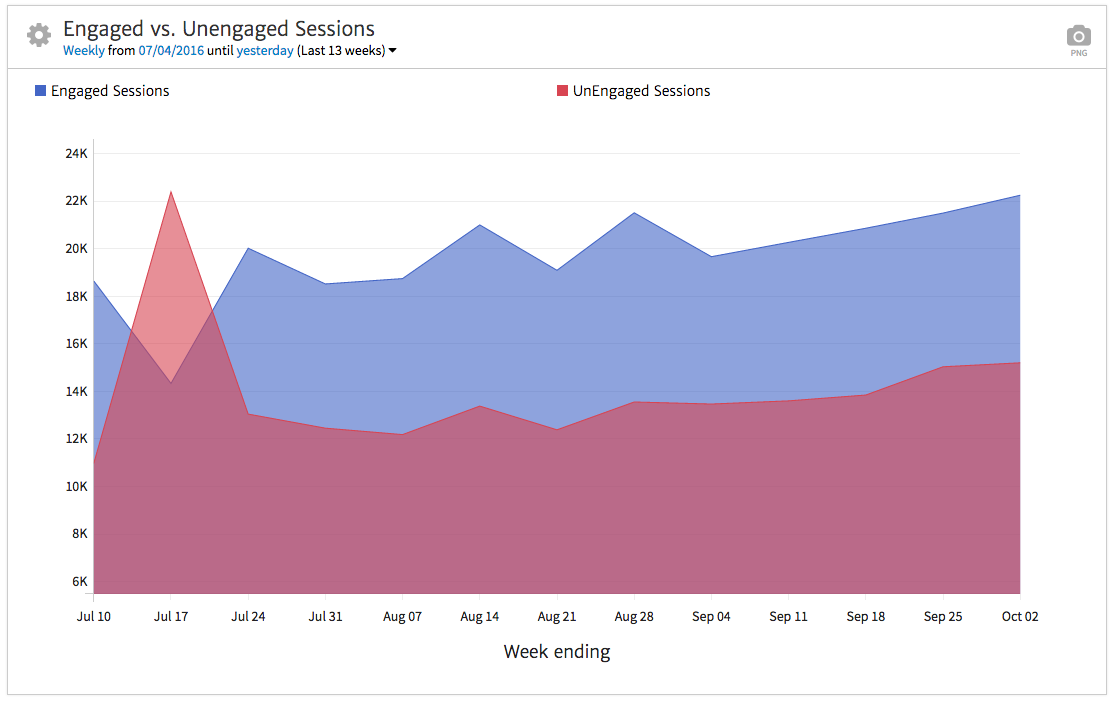
Engaged Visits
Every business owner’s goal is to “make more money.” Often that goal projects itself on a website with a demand to “get more traffic.” But as much as you can rave about spiking increases in website users, sheer traffic volume doesn’t correlate to business success. If people look at your site for two seconds and immediately bounce off, those likely aren’t your target customers. Or if they were, they clearly didn’t see what they wanted, which is an entirely different problem. Either way, you should strive to measure growth in users who are actually engaged on your site, counting the people who are browsing your site and learning about your brand.
Defining what data points define engagement will differ based on your business model. However, most digital agencies want to attract audiences who will spend time reviewing services, case studies, and blog content in order to understand who you are and what you do.
Megalytic offers an “engaged visits” metric allowing you to count how many Sessions fell within a certain time threshold (e. g., spending more than 60 seconds on the site). Time spent on site offers a clue as to how interested people were in looking at your content and ultimately considering your brand.
Evaluate changes in engaged visit volume over time to determine how well your site is attracting people who are find your content worthwhile. You may find that design changes to your site or increased blogging efforts have helped or hurt this metric based on the quality and relevance of your efforts. When you do strike on an action that improves engagement, dissect and study it. Only by having a strong sense of what worked can you replicate it.
Conversion Rate
Conversion rate measures the percentage of website users who complete an action, whether downloading an ebook, contacting you, or making a purchase. For more ideas on tracking conversions and conversion rate in Google Analytics, see our article on Translating Business Goals to Analytics Goals.
When monitoring conversion rate, marketers often fall into one of two traps. First, some may solely monitor conversion rate to the point of people filling out a contact form or signing up for a free trial, not measuring conversion to the end goal of becoming a paying customer. This approach can potentially result in measuring junk leads that never turn into real business.
However, the opposite extreme can equally limit properly measuring a business’s goals. While it’s natural and good for a business owner to focus on ROI, some marketers refuse to measure conversion rate for anything other than conversion to final sale. This approach leaves out the fact that many potential customers interact with a business multiple times in different ways before converting.
Ultimately, you need to measure conversion rate for early touchpoints, like ebook downloads or contact form submissions, while also measuring the customer conversion process all the way to the final sale. Some customers need a long sales cycle where trust and interest is built across multiple interactions. Others know exactly what they want, and they want it now.
The best insights tie together the actions of both groups. It’s essential to evaluate multiple conversion rates throughout the customer journey in order to gain a full picture of how well your agency is converting new customers and identifying which conversion points can be improved.
Cost Per Acquisition
When prospecting for leads, you want to determine what channels are most cost-effective in obtaining new customers. Of course, with real-life salespeople, you may just scale their salary with commissions based on how much revenue they bring in. However, you need to have the right framework in place to measure the value of online channels, looking at the sources where leads came in and connecting the dots with people who convert into paying customers.
Paid channels like AdWords offer the most straightforward method of determining cost per acquisition (CPA). Set up conversion tracking, run your ads, and measure the resulting CPA throughout the campaign’s duration. However, as with conversion rate, you should make sure to measure not just early conversion points, like whitepaper downloads, but also the final conversion to a sale. Determine both the cost you paid for quality leads, in addition to the resulting revenue, tying in what ad copy and keywords drove the most qualified leads at the most efficient cost.
Other channels, such as organic search, require more analysis to determine a CPA. However, you can evaluate the value of the time spent investing in SEO for your agency, accounting for team salaries and number of people involved in projects. Of course, keep in mind that attaining a hard-and-fast number isn’t always possible, and SEO is a long term game.
Lifetime Customer Value
Beyond the point of making the sale, you want to obtain clients who will stick with your agency for the long term and deliver ongoing value. While a contract may start small, a client may grow over time and pay you more down the road. At the same time, an initially large contract may end up going way out of scope and bring in little real revenue for your agency.
Measure the lifetime value that clients are bringing in, looking not only at how much they pay you but also how much time you’re investing in them. Some high paying clients may not be worth the time and effort if they don’t understand your work and constantly eat into extra time above and beyond their contracts. At the same time, you want to invest significant time in the right clients who will appreciate what you do and choose to expand their service contract.
Tying the lifetime value back to the previous points, look at cost per acquisition and conversion rate for clients who are actually delivering the most value. Of course, this measurement will require keeping track of how people touched your brand from the initial engagement, but the setup will be worthwhile in determining how to drive more of the right kind of clients while developing the ability to spot the wrong ones early on.
Conclusion
We’ve touched on several key data points to measure for strategizing growth of your digital agency here. Of course, several of these require the proper setup to be in place, from Google Analytics to CRM systems that can tie prospects to their sources and track lifetime value. It also requires a commitment to process and data input to capture the metrics you need. However, the investment in setting up the proper tracking and educating your team for monitoring the results will pay off. In the end, you’ll have a better understanding of how your agency’s online presence is growing over time and how that growth results in a meaningful contribution to your bottom line.


